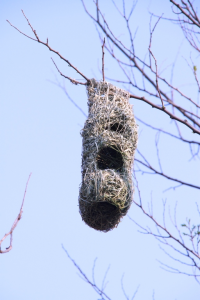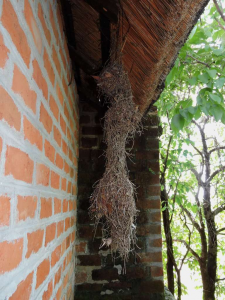Weaver species category
Choose different species category from drop-down list and press 'Go' button.Why do weavers sometimes build two or more nests suspended below each other?
Many weavers are polygynous, meaning that the male wants to try and attract several females to his colony. The down side is that the male needs to build several nests, and nest building is energetically costly. It takes a weaver at least a day to build a typical nest, but he still continues adding material for a few days at a slower pace. When females come to investigate nests, the male displays mainly from the newest nest. Females usually only accept green nests, ie built within the last few days as the material soon fades to brown. If a female accepts a nest, she will lay eggs and continue breeding even though the nest will fade to brown. If a female is not interested in a male or his nests, she simply moves on to another colony or male.All this means that after builing a nest, a male has a window of a few days to get a female to like it. After that the nest is wasted. So the male breaks down brown nests in his prime spots so that he can build a new green nest and try all over again. This cycle continues through the breeding season.
To break down a nest does not require too much energy, and a male usually breaks it down in 20-30 minutes (in between other activities). Sometimes, however, males don't bother to even spend the tiny bit of energy to break down a nest, but simply start builing the next nest under an old brown one. Lesser Masked Weavers probably do this more than most other species, but the photos below show that several other weavers also build double or triple (or more) stories!
If you have a photo of a double (or more) decker nest, please submit it PHOWN, PHOtos of Weaver Nests, is a Virtual Museum, citizen science project of the Animal Demography Unit, to collect and monitor breeding distributions and colony sizes of weaver birds globally. To take part, register and upload records at Virtual Museum (read the "How to" pdf for help).
Some weavers where double (or more) nests have been recorded:
Lesser Masked Weaver
Red-headed Weaver
Cape Weaver
Southern Masked Weaver
Village Weaver
Spectacled Weaver
Sakalava Weaver
Baya Weaver



















